Museums and Exhibitions in New York City and Vicinity
| Home | | Museum Guide | | International | | Architecture & Design | | Theater |
GLENN LONEY'S MUSEUM NOTES
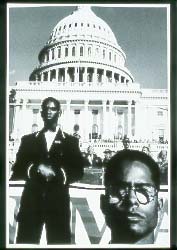
| |
| "A DAY OF ATONEMENT" IN DC—In Brooklyn Museum's Black Photograpy Show, "Committed to the Image." Photo: ©Ron Campbell/1985. See: Black Photographers at BMA. | |
[01] Black Photographers at BMA—Nude Female Christ "Last Supper" Outrage
[02] BMA's "Family Album: Brooklyn Collects"
[03] Big BMA Bucks for Better Building
[04] Armillary Sphere in New Weston Pavilion at AmNatHist Museum
[05] Andreas Gursky's Overblown-Up Photos at MoMA
[06] Van Gogh's "Postman" Delivers for MoMA
[07] MoMA's "Workspheres"—Virtual Work in Virtual Worlds
[08] Whitney/MoMA Co-op: Mies in Berlin/Mies in America
[09] Josephson Photo Retro at Whitney
[10] "Pictures of Dust" from Whitney Sources
[11] From Petersburg to Las Vegas: "The Global Guggenheim"
[12] Jean Poyet's Magnificent Medieval Miniatures at Morgan
[13] Charles Ryskamp's Five-Century Drawing Retro
[14] Chinse Painting in Times of Change at the Met
[15] Two Master Draftsmen of Parma: Correggio & Parmigianino
[16] Met Shows Holy Heads & Foot: Treasury of Basel Cathedral
[17] Dutch Interiors: Vermeer & Delft
[18] Photography at the Met: Process & Preservation
[19] Saving Photos & Works-on-Paper at Met
[20] Dash To Dahesh: "Gérôme & Gouptil"
[21] Goya & Manet at CUNY Grad Center
[22] Pricey French Pastels at Wildenstein
[23] Arts at the Park Avenue Armory
You can use your browser's "find" function to skip to articles on any of these topics instead of scrolling down. Click the "FIND" button or drop down the "EDIT" menu and choose "FIND."
For editorial and commercial uses of the Glenn Loney INFOTOGRAPHY/ArtsArchive of international photo-images, contact THE EVERETT COLLECTION, 104 West 27th Street, NYC 10010. Phone: 212-255-8610/FAX: 212-255-8612.
Copyright © 2000 Glenn Loney.
For a selection of Glenn Loney's previous columns, click here.
Ultimately, of course, such separatist categorizing can be defeatist, even diminishing the achievements of the photographers as individual artists and documentarians. But they are not exactly being celebrated in that way by this show.
Instead, a Committee of Four spent two years reviewing slides and prints for this exhibition. As the BMA press-release makes clear—and the show certainly demonstrates—"the primary criteria for selection were originality, standard of printing, social or historical significance, and subject-matter." [Italics added.]
As a number of the photos are fairly standard stuff, the first criterion obviously didn't have nearly as much weight as the last two. To meet these latter criteria, many of the 94 contemporary African-American photographers chosen have indeed provided a visual chronicle of lives, life-styles, and major and minor events involving their Brothers and Sisters over the past half-century.
But the range of photo-subjects is by no means limited to the United States. Some impressive images summon up the mysteries of ancient Africa.
Each of the 94 chosen is represented by two works. Many of the most powerful images are in black & white. There are even a few shots with Whites in them!
Among the select Elect are the much-admired Gordon Parks, as well as Ernest Withers, Carrie Mae Weems, Cynthia Wiggins, and Delphine A. Fawundu, whose powerful b&w image is effectively the poster-girl and catalogue-cover for the show. Through the door of a shabby white bathroom, one sees the voluptuous bare black back of an African-American beauty, sitting on the rim of the bathtub, her hands clasping her shoulders.
But the African-American photographer who is getting the most attention out of this Brooklyn show is undoubtedly Renée Cox. One of her two entries is a very amusing color shot of a Black Beauty sitting on the rim of Miss Liberty's crown. Cox calls this apparent digital manipulation "Chillin with Liberty."
Who can even notice this small-scale sexy jest, compared with Cox's major Altar-Piece, installed in a special room, rather like a sacred shrine? Cox calls this visual parody of Da Vinci "Yo Mama's Last Supper."
Instead of an effeminate Christ at the center of the Passover Meal, Cox exposes her naked self, standing with the white cloth used to depose Christ from the Cross over her arms. She looks like a figure from the Oberammergau Passion Play. But you will never see a female Christ—with her vaginal area exposed—on stage at Oberammergau!
Certainly not if the Roman Catholic Archbishop of Munich/Freysing could prevent it! Not to worry: the pious folk of Oberammergau would never condone such a blasphemy themselves.
But it was not from New York's Cardinal-Archbishop Edward Egan that Roman Catholic outrage initially came raining down on the photographer and the Brooklyn Museum of Art. [But His Eminence did finally weigh in with a denunciation—complete with a color-photo of the Divine in his rich robes—on the front page of the Daily News. He dismissed Ms. Cox as "Pathetic."]
Instead, New York City's self-appointed Censor and Guardian of Public Morals, Mayor Rudy Giuliani was the first to launch a scorching attack on the BMA for its "Anti-Catholicism" in exposing this five-section quasi-religious panorama to public view—partially subsidized with public funds.
One would have thought the BMA's embattled director, Arnold Lehman, might have learned a lesson in Arts-Diplomacy after the high-profile public scandal provoked by the Mayor last fall over the British show, "Sensation."
Rudy the Good was furious at the gratuitous attack on Roman Catholic sentiments and beliefs presented in that show. There were, in fact, several works which offended, regardless of one's religious or sexual orientation.
But Mayor Rudy's chief target was a large portrait of an African woman with a huge hunk of dried elephant-dung for a breast. Actually, the Black artist's delicate, jewel-like technique created a rather striking painting. Had Chris Ofili merely titled this "African Goddess," few would have taken much notice of the work.
To call the portrait an image of the Virgin Mary was, however, too much for the Mayor. He took offense in the name of all good, pious, decent, devout Catholics. Nothing was said about the sensitivities of Protestants, who generally do not view Jesus' Mother as the Queen of Heaven.
Of course, at that time His Honor was considering a run for the US Senate and was well aware of the large group of Roman Catholic voters upstate. Now that his tenure as Mayor is drawing to a close—and he cannot succeed himself because of term-limits—he may well be preparing to run for Governor. He will need all the votes he can get, especially the Outraged Catholic Vote!
Apparently, he has written off Protestants as unworthy of his concern. Or he is such a tunnel-vision Catholic himself, that he does not realize that the scene and events of the Last Supper are central to the beliefs of most Protestants as well as Catholics: "DO THIS IN REMEMBRANCE OF ME!"
Surely some Methodists, Baptists, Congregationalists, Presbyterians, and even Episcopalians will be offended if and when they see Renée Cox's "Yo Mama's Last Supper." Not only is Cox jay-bird naked, but her Twelve Disciples are all Black men, some with dreadlocks.
Unfortunately, some self-proclaimed Waspy Christians still get upset, even angry, when they see images of the Christ—made for Black or Latino congregations—as a Black or Hispanic Man.
There are so many layers of blind faith, symbolism, sectarianism, intolerance, violence, hatred, and self-righteousness bound up in the 2,000-year Evolution of Christianity, that it is difficult, if not impossible, for many pious people to look at an art-work such as Ofili's or Cox's as anything but a demonic plot or an attack on their most cherished beliefs.
The Mayor is obviously among these Righteous Men. But it may be exactly that distinction that Cox is questioning in presenting a nude female Christ-figure at the Passover Supper.
At first glance, at the press-preview—when one could get through the thicket of TV-cameras, preparing for the newest Prime-Time Evening-News BMA-Scandal—the panorama looked like a hokey parody of Da Vinci's famous dining-room mural in Milan.
Repeated viewings, however, suggest deeper layers of meaning and intention, some of which are more Feminist than Black.
I don't like this work very much, but not because of any religious sensibilities or cultural conventions. One could say, for instance, that parodying a Da Vinci Masterpiece is the real sacrilege—not the alleged mockery of Christ and Religious Beliefs.
No, the problem for me is that all five panels look like the work of a smart, trendy talented, bad-assed commercial photographer, creating one of those Major Ad Campaigns for LifeStyles. Few of which involve real people—only Paid Posed Professional Models doing trendy, consumer-oriented things in expensive outfits.
In the Fall, the Mayor was threatening not only to cut off the Brooklyn Museum's city subsidies, but also to dispossess it and its world-class collections from its historic Beaux Arts building on Eastern Parkway.
Civic and Cultural Leaders rallied to the BMA's defense. In the event—although it cost the NYC taxpayers a lot of money to pay attorneys to fight the Mayor's battles on behalf of the Blessed Virgin and the Catholic Vote—Rudy lost.
This was shortly after he'd been demanding the posting of the Ten Commandments in all Public Schoolrooms. This was another vote-getting ploy, designed for the Religious Right, for, if our kids cannot read, how could they make sense of Moses' Decalogue?
Especially when the President of the United States and the Mayor himself had been caught breaking a very important commandment. Perhaps they misread the Commandment against Adultery? Being Adults, they thought it was OK?
After the Mayor's on-going affair with a woman-not-his-wife was disclosed in the press, some social wits suggested he should post The Nine Commandments in the schools!
The Brooklyn Museum of Art has such extensive and outstanding collections that it should not feel the need to court sensation and scandal to get the public to come out to Brooklyn. By many accounts, it is the Second Largest Museum in the United States. Its problem in attracting the public is not just that it's in Brooklyn, but that Number One is across the East River on Fifth Avenue.
This current embattled exhibition is effectively in service of an impressive new photography book. It bears the title of the show and is handsomely designed and published by the British firm of Merrell. [Hardcover—$39.95/Soft—$24.95]
That is certainly a more respectable promotion than "Sensation," which looked—even in its sponsorship—like an only slightly veiled attempt to increase the auction-market value of Charles Saatchi's dubious but intentionally shocking collection of works by Young British Artists.
Some of the Contemporary Black Photographers' images are even seen to better advantage in the Merrell book than on the walls. One can certainly study them in detail with greater ease in the catalogue—which has helpful short comments on the photos by their creators. Photo Sensations!
Black Photographers at BMA
[Closing April 29, 2001]
Titled "Committed To the Image," the new and controversial show at the Brooklyn Museum of Art is sub-titled "Contemporary Black Photographers." This is not quite the same category-idea as "Women Playwrights," but it does suggest that Black lensmen & women look at their world differently than, say, Asian or Hispanic or Wasp photographers.
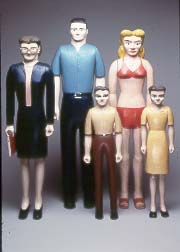
| |
| HARVEY FIERSTEIN'S TINY FAMILY—On view at BMA, in "Family Album: Brooklyn Collects." | |
One way, as the Met did recently, is to raid your basement storage for the bizarre and garish gifts and legacies left by filthy-rich but taste-poor Robber Baron board-members who died decades—or even a century—ago. These unusual—if once costly—oddments then can be presented as a survey of American Taste in the Mid-19th Century.
And what did New Yorkers and Tourists alike learn from this exhibition? That Our Emerging National Taste was almost embarrassing, even when the Local Metropolitan Midases bought alleged Masterpieces abroad on their Grand Tours of Europe.
MoMA—preparing for a costly and disorienting period of new construction—also recently plundered its storage-drawers for artworks already on the premises to mount a relatively low-budget and even low-wattage show. The organizational gimmick of Modern Starts was to show works organized by subject-matter, media, or techniques.
The Brooklyn Museum of Art—while it certainly has rich treasures in storage—has chosen to be more Contemporary. Its current show features representative objects from the personal collections of both current and former Brooklynites.
While there were still the considerable costs of mounting and insuring such a show, it was marginally easier than getting priceless objects out of storage. And there was sponsorship from KeySpan, which possibly wanted to increase Brand Identity.
Now, while you or I might think twice about lending our Albrecht Dürer originals to the Pan-German Museum of East Stroudsburg, putting your objects-d'art on display at a major museum such as BMA obviously increases their resale or auction value, from the added provenance of the show & catalogue. Charles Saatchi understands this very well.
I don't want to attribute such base monetary motives to most of the lenders to this interesting but uneven show. It seems probable that most of the collectors whose objects are on display genuinely respect and even like the artworks they've loaned.
Only an overly admiring owner could really love that Julian Schnabel broken-crockery portrait. Just imagine having to confront that across the breakfast-table every morning!
You didn't have to actually live in Brooklyn to be included in this "Family Album" of a show. But you did have to have some kind of connection with this NYC Borough—which was once the Fourth Largest City in the United States.
I lived 13 years on Hicks Street in Brooklyn Heights. And I taught for 30 years at Brooklyn College. But I was not asked to contribute to the Album. Could this possibly have been to avoid ethical conflicts of interest in my writing about the show?
The items on display—credited to Henry Luce III—made me wonder where in Brooklyn Luce lived. And when? Winston Churchill's mother—my relative-by-marriage—was born in the Heights, so historically it was no disgrace to live in that borough.
It was, however, a surprise to learn that both arts patrons Susan Weber Soros and Iris Cantor were born in Brooklyn. Ms. Soros is the dynamo of the Bard Graduate Institute in the Decorative Arts on West 86th Street.
And Mrs. Cantor—and her late husband, B. Gerald Cantor—have been extremely generous patrons of the Brooklyn Museum, with both an auditorium and an impressive collection of Rodin castings. I once thought they'd bought Rodin's foundry, as Cantor Rodin Collections are also at the Met Museum and at the Art Gallery of my alma mater, Stanford University. In addition, their benefactions to New York University have been considerable.
Artifacts and artworks range from Ancient Egypt to Coney Island and beyond. Harvey Fierstein's hilarious collections of pitch-booth prizes and fun-house decorations remind us of the flowering of Popular Culture along Brooklyn's beaches.
Harvey's tchotskes aren't yet in the league of Andy Warhol's cookie-jars, but their provenance, from being in this show, may help boost them up the ladder of potential auction-prices!
New Yorker cartoonist Roz Chast has drawn—in her inimitable style—a Family Album visual, and there are some Chast sketches in the show.
The Chast image on a special invitation is being sent to some 10,000 former Brooklynites around the nation. They are offered free memberships and are also invited to a VIP reception.
There may be donation-strings attached, however, for the BMA is preparing for its long-planned expansion, both before and behind the museum complex.
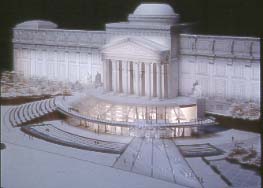
| |
| POST-MODERNISM MEETS BEAUX ARTS—New Glass Pavilion for Brooklyn Museum of Art. Photo: ©Jack Pottle/ESTO. | |
We will all Get Over It, of course, as we have with new wings at the Met and the American Museum.
And we do not have long to wait, for that open-air museum of handsome architectural decorations salvaged from demolished old Brooklyn buildings is already being scooped out as a construction-site. The busts, cornices, and fluting have been removed to a wire cage beyond the parking-lot—which will also undergo changes.
The first element in the newly revised plan for expansion and modernization is soon to commence. It will be a marvelous glass entrance pavilion, designed by the [James Stewart] Polshek Partnership, who have recently done such outstanding work at the Natural History Museum's Hayden Planetarium and Rose Space Center.
The new BMA entrance will be a sheer glass pavilion, "stepping up to and radiating out" from the existing facade. Grand steps on either side, flanking it, will lead to an upper promenade, ideal for admiring the new fountains and any open-air performances staged in the newly developed arena before the museum. Today, the area between Eastern Parkway and the museum facade is a badly designed and virtually unused space.
But all this will cost money, lots of it. Construction costs are expected to devour almost half of the $120 million BMA is currently raising in its Campaign for the BMA 2000-2005. $50 million will be targeted for the museum's endowment.
Over half of the total has already been raised, but those former Brooklynites who come to see "Family Album" may well want to get out their checkbooks and help.
Among current pledges of funds is one from the Mayor's Office. Considering his ongoing threats to close down the museum, this may be a pledge the trustees should not count upon too firmly.
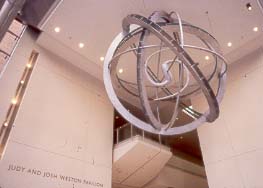
| |
| ARMILLARY SPHERE OVERHEAD—Installation in new Weston Pavilion at AmNatHist Museum. Photo: ©D. Finnin/2001. | |
The glass-box space is dominated by an immense Armillary Sphere sculpture. Inspired by ancient Chinese and Renaissance armillary devices—which showed the relationships of the earth, stars, planets, sun, and moon to each other in space—it has been conceived primarily as a symbolic sculpture.
But not as a giant-sized device an astronomer or navigator could actually use. It weighs some 3,500 pounds, after all. It is also Millennial, showing positions in space as of January 1, 2000.
New York and its denizens are smaller than small in the vastness of space, as the impressive Hayden space-show demonstrates daily. Nonetheless, they have their spot on the Observer's Horizon ring of the sculpture.
But six rings compose this unusual hanging sculpture. We are obviously not alone in space, for there are also rings for the Ecliptic Plane, the Milky Way Galaxy, the Galactic Plane, the Supergalactic Plane, and the Galactic Octant Rings, around the Galactic Polar Axis.
The sphere was designed by David Harvey, VP for Exhibition, assisted by Molly Lenor & Joey Stein of the museum staff. Together with the sphere, a mosaic replica of the Aztec Sun-Stone/Calendar set in the entrance floor, and wall-cases of small but precious antique instruments for measuring the Heavens, Harvey says, show that Time, Space, & History are symbolically woven together.
The handsome glass-box entrance opens the Museum for the first time at its backside to its neighbors on Columbus Avenue. The open area at the rear—which once should have been filled with more museum segments—was over time developed as Theodore Roosevelt Park. It was never very inviting, but now it has been greatly improved. Not so long ago, Teddy Roosevelt, the Great White Hunter, wouldn't have sat on one of its broken benches without a double-barreled rifle.
In late spring, the New York Times Capsule will be installed in the entry court as well. Designed by avant-gardist architect Santiago Calatrava, it will encase cultural artifacts from around the world. If New York, North America, and the World have not been destroyed by 3000 AD, the capsule will then be opened. For what purposes one can only darkly imagine…
What has happened to all that stuff buried in the Time Capsule in Flushing Meadows Park for the 1939 World's Fair? Did it mildew? Am I remembering incorrectly? But didn't it contain, among other precious cultural artifacts, one of Hedda Hopper's hats and a "My Day" column by Eleanor Roosevelt? Or is this just an Orson Wellesian fever-dream of the 1930s?
All the handsome and eminently functional additions to the northwest quadrant of the Natural History Museum's site are the designs of the [James Stewart] Polshek Partnership. Polshek and his able staff have just completed the stunning new Scandinavia House on Park Avenue South, as well as a new theatre-space in Carnegie Hall. And, as noted above, at the Brooklyn Museum of Art.
But you may have to pardon them for their work on the Clinton Library.
Nonetheless, I admire Polshek's designs so much that I have just nominated him for a Municipal Art Society Award for his varied architectural enhancements at the American Museum.
MoMA Modernity—
Andreas Gursky's Photo-Epics at Modern Art
[Closing May 15, 2001]
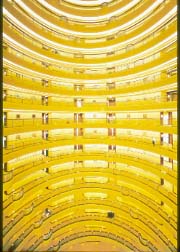
| |
| SHANGHAI POST-MODERNIST VERTIGO—An epic photo by Andreas Gursky, on view at MoMA. | |
Obviously, Gursky has a very good camera and lenses. There is a point-of-no-return with enlarging 35mm images.
Nonetheless, I admire his "eye" for seeing something special in the solitude of vast empty spaces of Nature, relieved only by a massive man-made highway overpass. Or an endlessly repeating stretch of apartment-windows in a Modernist facade, its basic functional inhumanity distinguished only by varied curtains, shades, and mini-scenes seen through the tiny windows.
Gursky's elongated photo of the colorful if garish packaging of rows and rows of 99-cent specials—on shelves in a store-space of no character whatsoever—makes its own silent but mordant comment on our bargain-hunting Consumer Culture.
Balancing emptiness & soullessness, there are some turbulent enlargements featuring masses of energized people. Some are caught up in a Rave. Others appear to be in the thick of stock-trading at the Bourse. At first, one may wonder at the powers of a lens which can perceive such detail over such a panoramic view.
Then it becomes apparent—as press backgrounders indicate—that Gursky has become a modern master of digital manipulation of photo-images. Had someone attempted this in collage, the faint edges of photo-joins would eventually show somewhere.
Not here, however. On the tumultuous trading-floor, although the excited people seem energized by the same stimulus, it's clear that some are in larger scale than others. The manipulated blown-up image conceals another silent commentary on the nature of the scene and its participants.
Gursky finds his often attenuated scenes on travels to many lands. But special cultural and architectural distinctions seem to be eroding. Even Nature begins to repeat itself in some form of Global Format or layout.
Recently, the Goethe Haus on Upper Fifth Avenue had a small-scale show of large-scale horizontal photo-blowups like Gursky's. Most of these focused on empty Autobahns, bridges, and overpasses in the former East Germany. The very fact of a major modern multi-lane highway being completely void of traffic—of even a solitary hitch-hiker—makes a powerful, if forlorn, statement about this dysfunctional—if seemingly prosperous—Post Socialist society.
Unlike the former West Germany, it is still fairly easy to find an empty Autobahn in the new/old DDR. The official Federal German agency for sorting out formerly state-owned shops, crafts, and factories in East Germany after 1989—the Treuhand—closed down a lot of East German industries, leaving towns and cities without employment for their inhabitants. This left the highways wonderfully free of traffic. It also prevented former "Ossie" industries from competing with their western counterparts. True-Hand Trustees indeed!
So it may well be that Gursky's epic photos speak much more powerfully to Central Europeans than to metropolitan Americans.
Nonetheless, they are well worth seeing. Although they fill several large galleries at MoMA, they are themselves so large that you can "do" the show-circuit fairly rapidly.
For those unable to see Gursky's work on the walls, there's a stunningly designed large-format book [12" x 13"] which makes possible some sense of the scale of his photos. There are even detail blowups of his blowups. The 196 pp. catalogue presents 115 color illustrations, with 18 duotones. There are 59 full-page plates. [Hardcover—$65/Soft—$35.]
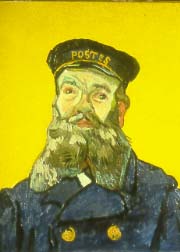
| |
| VAN GOGH'S "POSTMAN"—One of five portraits of Joseph Roulin now at MoMA. | |
Crowds are thronging the small chambers and looking closely—when they can get close—at the similarities and contrasts of Van Gogh's colorful portraits of the one man—other than brother Theo—who was really kind and considerate to him near the close of his turbulent life of disappointment and frustration.
MoMA has prepared a handsome six-fold brochure with each of the five portraits in this show reproduced in full-color. It makes a wonderful display on the bookshelf or the desk. Mine cheers me up even at this moment. And I got a handful of the brochures to give to friends and students.
Wall-texts help explain what Van Gogh saw in Roulin's face—and in his large heart—that he was able to capture and gradually reveal in successive paintings, made over the span of winter 1888 through spring 1889.
Roulin cared for Van Gogh immediately after he'd hacked off a part of his ear—that defining biographical detail for many first encountering Vincent's genius—and continued to support him with counsel and friendship.
Joseph Roulin, it would seem, was the epitome of the Civil Servant!
But these remarkable paintings are now more than 100 years old. Are they still to be classified as Modern Art? While they aren't yet Old Masters, they have now passed over into the realm of Classics of Art History.
Is it time to separate MoMA's holdings into Modern Art and Post-Modern Art? But MoPMA isn't so easy to pronounce. Or to type…
Please Take a [Post-Modernist] Seat!
Visionary "Workspheres" at MoMA
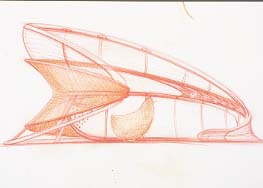
| |
| MIND'SPACE CONCEPT DESIGN—A revolutionary office-innovation for MoMA's "Workspheres." | |
Mowing hay or mowing the lawn don't really count as Work anymore. No wonder both Cows and Farmers are going Mad! Husking corn or churning butter? Forget it! No one "candles" eggs anymore—to see if there's a speck of sperm inside…
Why dig ditches by hand when computer-operated backhoes can do the job far better and faster? Of course, with a circuitry-breakdown, they can always go berserk, like the Sorcerer's Apprentice. And wreak Epic Havoc… But then we haven't figured out how to contain earthquakes either. But those aren't devised by MIT experts—or designed by Swedish Post-Modernists.
Nonetheless, some of the compact new office-work-units on display at MoMA are in themselves Works of Art, veritable Sculptures-as-free-standing-objects. These are Work-Universes, self-contained Work-Spheres—in which one can effectually cut off, or even eliminate, the real world and do Virtual Work in a Virtual World.
None of these Work-Stations is shown facing an actual window. Or even a Virtual Window! So this may be a visual metaphor for the self-imposed Solitary Confinement of the near future, as devised by Time & Motion experts and trendy artist-designers.
Any of these Workspheres could just as well be installed in the proverbial Lead-Lined Cave in the Rocky Mountains of Colorado. In the likely event of Nuclear Holocaust—increased if everyone is working in bunkers—there might be a tremor, but the on-site technology would survive. Whether the Work-Files and the Modems would function—without external power-sources—could of course be guaranteed by atomic batteries.
But with nobody left alive outside to receive Messages and log your Work—and no Broadbands to carry either—what's the point of all this wonderful, colorful stuff?
Obviously, such expensive furniture and technology can only be purchased by high-profile, high-profit operations. Not by ordinary teachers, students, or free-lance writers. Not to mention auto-mechanics or used-car salesmen.
Much has been made of the Virtual Office of the Future, where you can work at home—with or without windows—and Fax or E-mail your spread-sheets, graphics, and copy to Dot.Com Central. The concealed problem is that the unseen, unknown work-at-homer is the easiest to fire. No one knows what he or she even looks like…
Even free-lancers need to come into the head-office now and then and shmooze by the water-cooler.
MoMA's idea of Work is obviously that done by Thinkers, Theorists, Scientists, Mathematicians, Writers, Researchers, Planners, & Stock-Brokers—all those quasi-Intellectuals who seldom work with their hands, except on a keyboard or mouse.
If all of them are increasingly isolated from Daily Life & The Real World, we will be in Very Big Trouble very soon, for these are the Minds which make Decisions and Stampede the Public into often Disastrous Action.
Despite all these futuristic reservations, the objects themselves, seen either as sculptures or art-installations, are well worth a MoMA visit. This Worksphere exhibition is rather like a small section of a mammoth Technology Trade Show at the Javits Center.
Ultimately, it and its catalogue may serve the same function as a show at the Javits. Some trend-setters will surely want to place orders for some of the work-stations on display.
The handsomely designed and produced exhibition catalogue will surely become a collector's item. If not an equipment order-catalogue as well. Its clinically sharp photos and the direct presentation of stools, cell-phones, watches, mini-TVs, desks, and the like could be mistaken for a visual sales-pitch.
Promoting the idea that computer-generated work can be done anywhere, the cover-photo shows a young woman seated with a laptop in an empty, grass-overgrown parking-lot.
Titled Workspheres: Design and Contemporary Work Styles, it comes in a stiff paper binding, at a cost of $35. It is replete with provocative essays on new ideas in designing for the office and the Digital Age. In its 224 pp., it includes 283 illustrations, 262 in color.
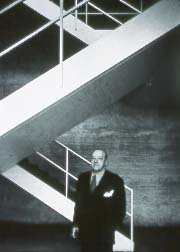
| |
| MIES IN AMERICA—Architect Ludwig Mies van der Rohe & Chicago Art Club stairs. Photo: ©Harry Callahan. | |
The forthcoming exhibition will provide a dual retrospective in depth, especially on the influence on Mies of Berlin as a thriving city of industry, politics, and culture.
Mies came to Wilhelmian Berlin in 1905. He began his architectural practice there in 1913, just before Imperial Germany launched World War I.
He continued his work during the bitter aftermath of the First World War, even into the dark years of the ascendancy of Adolf Hitler and the Nazis. He left Germany only in 1938, when it was no longer possible—in the face of Nazi disapproval of all things "International"—to design the kinds of projects in which he excelled.
His achievements in America are generally well known, but they were informed—if not so obviously—by the influences upon him of modernist architect-designer Peter Behrens, and, in turn, by the German neo-classic influence of Karl Friedrich Schinkel on Behrens.
[Before Behrens came to Berlin and left his visual mark on AEG, he had already distinguished himself at the Darmstadt Artists Colony at Mathildenhöhe, supported by Duke Ernst August of Hesse-Darmstadt. This center of Modernism has been restored and is well worth a detour between Frankfurt and Munich.]
At the Whitney—
Kenneth Josephson's First NY Photo Retrospective

| |
| CUBIST PRAYER-GRID—An Indian moment captured by Kenneth Josephson, now at the Whitney. | |
He is described in the museum's backgrounder as a "most accomplished but lesser-known" American photographer. In fact, curator Sylvia Wolf insists: "Josephson is an under-recognized contemporary master."
So strong is her, and the Whitney's, belief in his genius—and the achievements of his 40-year career—that the entire Third Floor is devoted to his photos. Some of the b&w studies are striking and unusual. Ordinary objects closely observed: a clutch of glowing light-bulbs, for instance.
But, after strolling through a gallery or two, I felt the images were too spread-out on the walls. There was too much dead-space between each of the images. More closely hung, they might have had more massed power.
Perhaps half the Third Floor would have been sufficient? The overcrowded Whitney Steichen Tribute is Overkill: too much, too closely hung. Josephson is Underkill.
Possibly this may have contributed to the depletion of the Ozone Layer. But its artistic-philosophical purpose was to demonstrate—or imply, or infer—Muniz's "concern with the fleeting nature of images." This Art Action was one of Muniz's "Low-Tech Illusions."
As an artist/photographer, Muniz must certainly know about the fleeting nature of images if he's ever had great Ektachrome images wash out on him after only a couple of months or years.
He began his career as a sculptor but, in photographing his works, he became more interested in the photographic medium. And in ways it can be manipulated and transformed.
This may have been sculpture's loss, but he now makes his photos using unusual materials to form the images he then photographs. Chocolate syrup and ashes have been employed in this endeavor.
For the Whitney, however, he has made drawings in dust from photographs of Minimalist and Post-Minimalist sculptures in the permanent collection. Tony Smith and Richard Serra are special dusty favorites.
But Muniz doesn't use any old dust. He gathered the dust for this commission from offices and galleries of the Whitney. That cannot have been easy, as the galleries are kept fairly clean. Except for what's occasionally hanging on the walls…
When Muniz has completed a dust-drawing, he photographs it and enlarges it for gallery showings.
What were Al Dürer, Leonardo, and Rembrandt thinking about anyway? All that fuss about subject-matter and technique! Mixing the pigments, sizing the canvas so the painting might last! Why bother, when you can celebrate the extremely transitory, fragile nature of an image, gone in a puff of smoke, gone with the wind, as they say…
Also on Show in the Whitney Mezzanine—
"The Things Themselves: Pictures of Dust"
[Closing May 20, 2001]
During the week of February 20, if you saw a skywriter outlining clouds in the skies above Manhattan, he was working to order. Conceptual-Minimalist artist Vik Muniz had created a cloud-form for the aviator to copy high in the air. Around the World with Thos. Krens—
"The Global Guggenheim:
Selections from the Extended Collections"

| |
| BERLIN GUGGENHEIM LOAN—James Rosenquist's "The Swimmer in the Econo-mist." | |
Thomas Krens, the Director of the [soon-to-be-worldwide?] Guggenheim Museum, is no Alexander, but he may be shedding a private tear or two that his dream of a Guggenheim in the eons-old Mönchsberg in Arch-Episcopal Salzburg has been foiled several times by the citizens of this famed Festival City of Mozart & Salt-Mines.
Nonetheless, he is undeterred by such momentary delays in promoting his World-View of Guggenheim Constructions, Collections, & Curatorship.
The current exhibition on Upper Fifth Avenue, in the Frank Lloyd Wright museum-masterpiece, is the first major showing of the Guggenheim's considerable pre- and post-war collections of Modern Art since 1992.
That's only a decade ago, but for some younger viewers, who are just discovering New York's cultural treasures, this may be their first opportunity to study and admire some very important modern works. For older art-lovers, this will be like meeting Old Friends after long absence.
Among the modern-classic artists with paintings, sketches, or sculptures on view are Robert Delaunay, Anselm Kieffer, Fernand Léger, Agnes Martin, Edouard Manet, Paul Klee, Jackson Pollock, Camille Pissarro, Paul Cezanne, Roy Lichtenstein, Pablo Picasso, Constantin Brancuzi, Vasily Kandinsky, László Moholy-Nagy, & Robert Rauschenberg. Almost, in fact, the Whole Gang! You get the idea…
With branches now in Venice, Berlin, & Bilbao, commissioned works from these venues can also be included in the Guggenheim Arts Riches. And with the recent signing of a Tri-Lateral Concordat between/among the Guggenheim, Russia's Hermitage Museum in St. Petersburg, and Vienna's Kunsthistorisches Museum, arts holdings and resources can now be circulated among all three institutions.
Modernist treasures from the Hermitage will soon find a welcoming exhibition-venue down on the Lower East Side of Manhattan when Frank Ghery's daring new museum-as-sculpture is constructed for the Guggenheim.
Even before that dream is realized, the Guggenheim and the Hermitage will be showing selections from their impressive collections in Las Vegas. Why Thomas Krens has resisted creating a new Guggenheim/Hermitage in St. Petersburg, Florida, is a mystery. It seems a logical connection. More so than Vegas—though Catherine the Great might have enjoyed herself pulling down on the slots. But because of Peggy Guggenheim's longtime connection with Venice, it must have seemed more familial that this new gallery should be sited in the Theme Park-style vastness of the Venice Resort & Casino.
That boastful art-collector over at the Bellaggio Resort & Casino won't be able to top this act with his Renoirs.
Even with Vegas' current drive to sell itself as a Family-Oriented Vacation Destination, neither art-works nor Treasure Island Pirate-Battles are as big a magnet—and money-spinner—as Gambling. Of course, in Vegas, they like to call it "Gaming." This makes losing all your money and your home sound more like Sport—than a Toxic Addiction.
You don't go all the way into the Nevada Desert to look at a Mondrian—but you may soon be looking at an empty wallet…
A Guggenheim-Hermitage showplace is currently being considered for the former Leningrad, now once again known as historic St. Petersburg. If Vienna has already joined in, can Salzburg now be far behind?
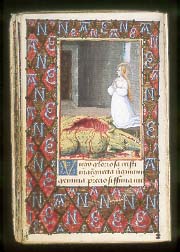
| |
| IT'LL TEAR YOUR HEART OUT!—Medieval Miniature of St. Margaret & the Dragon at Morgan Library. | |
Fortunately, the Morgan Library provides both magnifying-glasses and some enlarged photo-transparencies mounted in light-boxes. These glowing displays suggest that the Library shop is missing out on a potentially lucrative new art-souvenir.
Even a large framed page from a 13th century French Psalter on aging vellum cannot compete for color and intensity with one of these Poyet enlargements. Of course, if there is a large golden Gothic Initial on the page—still glowing with its bright burnishing from long ago—that's a different matter. Gold does not tarnish. Nor does the great artistry—shown in delicate miniatures on many of these venerable pages—dim with time.
Some very small missals and prayer-books on view were obviously well-used, their pages often thumbed and turned by royal—if unwashed—hands.
As medieval illuminators and miniature masters customarily did not sign their work, often after their deaths their finest achievements were forgotten. Also, as much of Poyet's work was done on noble or royal commission, such precious books either remained with royal families, or passed on to National Libraries or rich private collectors.
But in Poyet's own time, and immediately thereafter, his unique and subtle style was well known and highly prized among the wealthy cognoscenti. He created impressive works for three French Kings: Louis XI, Charles VIII, & Louis XII. He did not outlive the last, however, dying around 1503.
Poyet is credited with inaugurating a change from the traditional Late Gothic miniature style, introducing elements of Italian Renaissance painting into his delicate, but often powerful, images. He had, in fact, traveled in Italy and was influenced by the artistic visions of Mantegna and Bellini.
The current Morgan exhibition does more than celebrate Poyet's very special art. It also shows him in the context of his times, with predecessors and competitors. Some of the latter are definitely inferior, as this exhibit demonstrates. His most talented rival apparently was Jean Bourdichon.
Poyet did not always paint the miniatures entirely by himself. He maintained a workshop, though it may have been small. He would outline the subject, paint major elements, and leave the rest to his helpers.
The Morgan owns one of the most important and priceless medieval manuscript collections in the world. So some of the greatest treasures on display are from the Morgan's own shelves. But important manuscripts—seldom seen outside their home libraries—have been loaned for this show. Both Paris and Haarlem are represented.
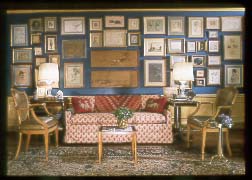
| |
| IF THESE WALLS COULD TALK!—Some of Charles Ryskamp's 5-Century drawing collection. Photo: ©Bill Cunningham/2000. | |
The possible reason this eclectic grouping is on Morgan walls, instead of the Frick's, may well be that some of the drawings on view have been promised to the Morgan. To which Ryskamp has already given some 120 works. In any case, the Frick's two intimate downstairs exhibition spaces are either too small for such an expanse of pictures or already booked with other exhibitions. The press-kit doesn't say if he has given any drawings to the Frick…
There are a number of outstanding images in this somewhat hotchpotch collection. Some are complete in themselves; others are studies for larger, more ambitious works.
But there is a visual problem with all this richesse. There are simply too many images on view for any to make a real impression. Close proximity detracts.
Add to that the tasteful, artistic, and costly way in which almost all the drawings have been matted & framed, and then even more wall-space is pre-empted by the surround, rather than the artwork itself. In effect, some of the frames and mats upstage the drawings.
Some would be better served by no surrounds at all. But some are so simple, so humble—like Degas' Flowerpots—that they might fade into the wall if they didn't have some framing boundaries.
A Question: When some of these become part of the Morgan's permanent collection of drawings & prints, will they stay in their frames—or be removed and stored flat in acid-free boxes and file-drawers? Removal gets rid of bulk and makes preservation and cataloging easier.
Many New Shows at the Met—
"19th & 20th Century Paintings
From the Robert H. Ellsworth Collection"
[Closing August 19, 2001]
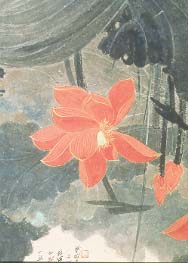
| |
| TRENDS MEET TRADITIONS—A modern Chinese Manifestation of Buddhist Joyfulness at the Met Museum. | |
Even a long hanging scroll—or a lengthily unrolled horizontal scroll—splashed with bold black indecipherable characters will soon tire the eye, unless relieved with deft and equally bold sketches between stretches of the ideography.
Viewing the actual limestone crags of Guilin, shrouded in mist—as I recently did on a four-hour boat-trip on the River Li—is initially a thrilling experience. But even the repetition in Nature begins to pall after an hour or so.
Misty limestone peaks seem to have been a staple of traditional Chinese brush-painting over the centuries. Artists young and old are still busily at work, churning them out in Guilin.
There is nothing repetitious, nor slavishly imitative, among the more than 90 paintings now on view, selected from almost 500 in the Ellsworth Collection at the Met.
In fact, the show highlights the important changes which appeared in this most prized of traditional Chinese art-forms with the clash of Eastern and Western Cultures in the 19th century. And especially during and after the collapse of the Qing Dynasty, which ended in 1911.
Some sought to preserve or even rediscover the essences of traditional Chinese—guohua or "national"—painting. Others melded the old with new Western concepts, techniques, and styles.
Only brush-painting—on hanging and handscrolls, on folding fans, and in albums—is represented in this show. No Chinese works in Western media are on display—though some able younger artists certainly did make oils on canvas their own.
Some of the works done in the Post-1949 Era of Mao, in the People's Republic of China, almost provoke amused Culture Shock. Their comparative freedom of visual expression reflects the Cultural Revolution's repudiation and even destruction of much of China's traditional culture and values. But the Dead Hand of State Socialism is also lurking in some of these modern paintings.
"Correggio & Parmigianino:
[Closing May 6, 2001]
Master Draftsmen of the Renaissance"
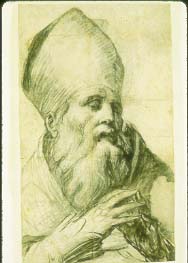
| |
| PIOUS PARMESAN—Parmigianino's drawing of a Bishop, on view at the Met. | |
It could prove a big tourist-attraction. But not as alluring as the city's lovely formal gardens, where the Grand-Duchess of Parma—Napoleon's deposed Empress—used to stroll.
Parma has, however, other claims to fame. Among them are the artistic achievements of two Renaissance artist-natives, Correggio & Parmigianino, both highly regarded draftsmen in their time.
Correggio was noted for his technique of sfumato, blending tones like smoke in his drawings and paintings. His genius with light and shadow is immediately apparent in the sketches on view, many in red chalk, his favorite medium.
Many are almost impressionistic studies for details of the massive and magnificent paintings he did for the dome of the Parma Cathedral and for San Giovanni Evangelista. When I was last in Parma, some of these incense-smoke-stained masterpieces were being cleaned. The Before & After contrasts were impressive.
On the evidence of his sketches shown here, Parmigianino, once a student of the master, was the more precise, detail-observing draftsman. His interest in figures, his skill in rendering real people, real animals, real objects is notable.
Parmigianino's sketch of a man holding up a pregnant dog by its forepaws, exposing its bulging belly and swelling teats, is immediately arresting. Some may find it vulgar, even offensive, but there is a special quality of affection and humanity about this small drawing. Was it his own dog?
Considering that the Met has recently hosted several interesting—but not truly major—exhibitions from cities and towns in Northern Italy, it's worth noting that all the sketches and studies in the current show are drawn from British and North American collections, both public and private.
The museums and galleries of Parma and Reggio Emilia have not been searched for items for the current exhibition. But Bergamo has sent the Met some of its treasures, as have other cities, for Met shows.
Mantua might well be revisited for some of the works of Giulio Romano, however.
Holy Heads & Sacred Feet:
"The Treasury of Basel Cathedral"

| |
| HOLY FEATS/SACRED FOOT—Non-Nike Reliquary from Basel Cathedral Treasury. | |
It's difficult enough to get enough money into the collection-plates to pay for upkeep of a church, let alone a cathedral. Fortunately, in much of Europe, the great historic cathedrals are National Landmarks and as such are protected and preserved by the State as well as by the Church[es].
No matter how Pious, Righteous, Zealous, and Saved such modern American Divines as Jerry Falwell & Pat Robertson may be, none of their devoted pastoral sheep is apt to spend thousands of dollars to have a golden head, studded with jewels, crafted by Tiffany or Fortunoff.
Protestants don't believe in such lavish & ostentatious exercises in piety. They also do not believe in Holy Relics—or even in Holy Water. Nor would any leading Protestant Theologian ever want to cut off the head of the corpse of a person who had lived a saintly life. Even modern Catholics would think twice about cutting off Mother Theresa's head to encase it in a skull-shaped Shrine of Gold.
Taking their cue from the Biblical Jews—and especially from Moses & the Ten Commandments—both Protestants and Muslims are opposed to the worship or veneration of images or idols, no matter how seemingly sanctified.
But this is no recent development. In fact, a major reason there are not more splendid treasures from Basel on display at the Met is precisely owing to the Protestant Reformation and the disastrous effect it had on art and culture in formerly Roman Catholic lands and cities. [Not to overlook Cromwell's Fundamentalist excesses in the British Isles!]
In Basel, inspired by Switzerland's own Martin Luthers—Ulrich Zwingli & John Calvin—newly Protestant and furiously anti-Catholic citizens stormed the historic Basel Cathedral, smashing great stained-glass windows, wrecking richly painted altar-pieces, tearing out decorated panels, desecrating priestly robes, and defacing magnificent sculptures.
What would burn was piled in the cathedral square and consigned to the flames. Fortunately, what survived of the most precious of the Cathedral's treasury had been locked away and was overlooked in the pious orgy of destruction of Idols & Graven Images.
When this priceless horde was found at last, it was moved to the Rathaus, where it was less than secure. Later, the collection was split in thirds, between the people of the city and of the surrounding country. As the countryside was impoverished, much of its population-based 2/3 of the treasures was sold off, disappearing into private collections. Or melted down, and lost forever.
What has survived, however, and especially those objects now on display at the Met, is remarkable for its creative imagination—within the varied styles of the periods represented, for its delicacy of workmanship, and for its evocation of a religious piety now lost. These Basel Treasures are artifacts and testimonies to Huizinga's famously-named "Waning of the Middle Ages."
The Basel golden head-reliquaries of St. Eustace & St. Ursula are striking in their stylization and simplicity. No one now knows what these saints might have looked like, much less if St. Ursula really had 11,000 or 1,000 Virgins accompany her into martyrdom.
Today, this amazing number of virgins in the ancient Roman Colony of Cologne/Colonia seems unlikely, as the population itself couldn't have been that large. Some scholars suggest this is a scribal error, the count increasing over time: More like 11 or 100 virgins, at the most…
After all, there are historically more important religious questions: "How Many Angels Can Dance on the Head of a Pin?" Or: "What could be as fine as/The thighbone of St. Thomas Aquinas?"
Netherlands at the Met—
"Vermeer & The Delft School"

| |
| DUTCH PEEK-BOX—Bramer's "The Curious," with Snoopers, even in Vermeer's days in Delft. | |
In fact, this large-scale exhibition is not purely about Vermeer. It's also about the prosperous and historic Dutch city of Delft—in which he lived and painted; it's about painters who preceded him, and those who were his near peers and contemporaries. It's about patrons and patronage in Delft; about allied arts in Delft, such as tapestry-weaving, tile-design, silver-smithing.
Both period paintings of the City of Delft and old engravings of its land-plan and notable buildings contribute to the viewer's understanding and appreciation of Vermeer's World. This show is a microcosm of mid-17th century Dutch life.
Rembrandt van Rijn moved from Leyden to Amsterdam, a thriving harbor-city. Franz Hals remained centered in Haarlem.
But to be at home in Delft, as Vermeer was, did not mean that he was working in small-town isolation. Delft was close to the Court in the Hague and its important patronage. Delft artists and artisans received commissions from abroad, including one from the King of Sweden. It was no provincial backwater.
Then as now, major Dutch cities were relatively near each other, unlike similar centers in France and Germany. Today, Delft—like Dordrecht—may seem a quaint old town, but in Vermeer's day, it was a thriving, bustling mercantile city.
Vermeer's contemporaries were fond of painting perspectives of the naves of real and imaginary Gothic churches. Especially Delft's venerable Oude Kerk, with its monumental Tomb of William the Silent, Stadthouder of the Lowlands.
From the imposing interior columns of such great churches—frequently with a dog or two sleeping on the marble floors—to the comfortable brick courtyards of Delft homes and convivial Burgher life seems not much of a stretch for these artists.
It's interesting to note how frequently the light—and not only in Vermeer's interiors—comes from a source or a window at the viewer's left of the picture. Sometimes it's even fairly high up—with lower shutters closed—so the light filters down on the subjects.
In a small but arresting country scene—Cattle and Sheep in a Stormy Landscape—by Paulus Potter, the cows and sheep are lit low and from the left side, not from above, suggesting not only the sun screened by storm-clouds but also close to the horizon, in late winter, perhaps? This is a very dramatic effect—and Potter was always very good with animals.
Potter's Figures with Horses by a Stable also owes its dramatic effect to special lighing. A white horse in a dark stable is hit by light from above—possibly a hole in the roof—so that it stands out in the center of the picture from everything else.
There are 15 Vermeers in this show, the famed Art of Painting coming from Vienna's Kunsthistorisches Museum, and The Procuress from Dresden. Color reproductions of the three Vermeers in the Frick Collection—just down Fifth Avenue from the Met Museum—are on view because Henry Clay Frick forbade the loan of the originals.
This is a wonderfully curated and designed show. Its visual treasures delight, and its interpretive wall-texts subtly instruct. Even if you've never been to Delft, you can sense something of its rich history, traditions, and culture from this exhibition.
The show may even make you want to visit Delft this summer. If so, don't miss the Franz Hals Museum in Haarlem, nor the historic city of Dordrecht, nor Utrecht. And certainly not Rotterdam and Amsterdam. There's even an annual Holland Festival in June, as an added inducement.
Obviously, those portraits M. Daguerre made on silver-plated copper sheets present very different problems than those of a fading Ektachrome slide. But the images on my own two daguerreotypes are now as ghostly as those on some slides made only ten years ago.
Among the photo-exposure & printing-processes on view will be Fox Talbot's salt-paper, with examples from the historic work of Edinburghers David Octavius Hill & Robert Adamson.
Two 1860s silver-albumen prints of Carleton Watkins' photographs have been chosen to demonstrate different conditions of storage and their effects.
Edward Steichen tinkered with some of his negatives and prints, making them difficult to analyze for potential restoration and preservation.
After you have seen this show, you may want to get new acid-free albums for your heirloom photos. For slides, you need clear plastic archival sheets. Cheaper slide-sheets contain chemical compounds which can cause the colors to fade and alter—and even the transparency itself to cloud or degrade.
Some photo-shops promise similar photo-miracles for relatively little money. So I thought it might be a good idea at last to have the long panoramic photo of my Dad and some 200 other World War I American Doughboys restored and copied.
The agency called to say that it would cost $600, including the four print-copies I wanted for family-members. None of them really remembers my father, however. And certainly not as he looked as a young US Army Trainee in Logan, Utah, in 1918.
Dad never got to France, as his regiment was demobilized after only three months of training. The Armistice had been declared. There was never to be any problem about "How Can You Keep Them Down on the Farm, After They've Seen Paree?" He never got to see Paris ever. Only New York, for the 1965 World's Fair. But, by that time, he had Alzheimer's, and he thought he was in San Francisco or Oakland…
I found this long, long photo years ago in the attic of the farmhouse on the Blue Tent Road. It was in a long wooden frame, from which I removed it, rolling it up to take it back with me to Manhattan.
After 30 years of being tightly rolled-up, I dared not try to unroll it, as the paper and the photo-surface would surely crack instantly. I guess that's what will cost $600: steaming the roll so it can be flattened and preserved.
I've already long ago seen the original photo full-length, so I do know what is hidden inside the role: Three rows of raw farm-boys, looking a bit scared in their awkward new uniforms.
I'm no longer sure I'd be able to pick my Dad out from all those young soldiers.
And I don't think the Met Museum's new Fairchild Center would be interested in helping me out with this project. They already have some one million items—works on paper & photographs—from departments across this vast museum which need conservation.
Photos pose special problems as works-on-paper, and the Center's photo-section is one of the few now in existence. Of course, not all photographic images are in fact on paper. Some priceless daguerreotypes and glass-plates—not to mention slides—require quite different preservation measures.
But then the procedures for restoring and preserving non-photographic documents and treasures can be as varied as the materials involved: Egyptian hieroglyphics on papyrus, medieval illuminations on parchment, calligraphy on linen, etc.
The Fairchild Center can be visited apparently. I'm almost afraid to go, as I do want to ask them about my Dad's photo. Call 212-535-7710 for more information.
Are Your Old Photos Fading?
At the Met Museum—
"Photography:
[Closing May 6, 2001]
A special dividend of the Met's opening its new Fairchild Center for Conservation of Works on Paper & Photographs is this interesting exhibition. Not only does it concentrate on the problems & solutions of preserving and conserving various kinds of photos, from different eras of photography, but it also deals with the processes of making photographic images.
Processes, Preservation, & Conservation"The Met's New Fairchild Center
Permanent Installation]
You've surely seen those ads for restoring Old Family Photographs? The original "Before" is so scratched, torn, rubbed, scraped, and faded into pale Sepia tones, that it's almost impossible to believe that the bright, shining "After" picture of Grandpa & Grandma at their wedding in 1886 is the same image "restored."
For Works on Paper & Photograph ConservationDash Off To the Dahesh—
"Gérôme & Goupil: Art & Enterprise"
[Closing May 5, 2001]
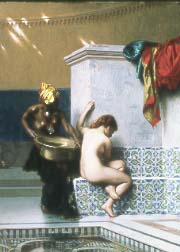
| |
| SEXY SALON ART—Gérôme's "Moorish Bath" at Dahesh Museum. | |
No, no! It's not one of those hush-hush National Enquirer or Hollywood Confidential items.
Many Seniors who have seen the recent film, Gladiator, must have recognized one central scene immediately. And not just because they'd already seen scenes like it in earlier films about the Excesses of the Caesars in Imperial Rome.
Even I, a Senior in good-standing, first saw this iconographic scene in an old engraving, and only later in a major motion-picture. The somewhat fly-specked and faded image was a copy of Gérôme's famed salon-painting, Pollice Verso. This means brutally: "Thumbs Down."
In Gérôme's tumultuous canvas, a triumphant gladiator stands over two vanquished adversaries, his foot on the throat of one crying for mercy. The bloodthirsty masses in the Roman Colosseum are vigorously jabbing their thumbs downward, eager for the Kill.
This almost legendary painting is briefly in New York—on loan from the Phoenix Museum—as part of a small but provocative two-pronged exhibition at the Dahesh Museum. The Dahesh specializes in 19th century French Academic Salon Paintings, and Gérôme was one of the stars, seen by some famous critics of his time as the greatest of the Academic Painters.
But his stardom was certainly advanced and secured by his relationship with his art-dealer, Adolphe Goupil, who was also print-maker and publisher. He it was who popularized Gérôme's images worldwide through etchings and prints of his works.
Their alliance was even further secured when Gérôme married Goupil's daughter. And Gérôme's name and works were spread abroad throughout the United States, thanks to a Goupil protegé, Michael Knoedler, who opened a shop & a gallery in New York. Knoedler & Co.—just around the corner from me—remains one of Manhattan's most distinguished art-galleries.
The current Gérôme show was arranged in collaboration with the Musée Goupil in Bordeaux, France, and the Frick Art & Historical Center, in Pittsburgh. It is not at the Frick Collection in New York, as its galleries are currently filled with treasures from Scotland's National Art Museum.
Not only are Gérôme originals on view, but also various states and versions of the plates and lithos which were made of several popular scenes. Including Moorish Bath and Duel After the Ball— The latter, in either its plain black & white or tinted reproductions, seems today a rather dismal subject to hang over the parlor mantelpiece.
But then, my Eminently Victorian Great-Cousin Barbara had huge engravings of both Landseer's The Stag at Bay and Gericault's Raft of the Medusa on her parlor walls. It was a terrifying place. But she also subscribed to The New Yorker, something I could never understand, in a little mining-town out there in the California High Sierras.
Gérôme's contributions to Orientalisme—that Western European, English, and American fascination with all things strange and exotic from North Africa, to the Middle East, and beyond to India, China, and Japan—were considerably enhanced by his sketching trips in search of such intriguing scenes and peoples.
Although he was not even born when Napoleon made his disastrous military expeditions into Egypt, Gérôme nonetheless was able to create—from his own experiences of that land, historical records, and his own fertile imagination—impressive scenes of the disappointed, defeated Emperor. But at least the French found the Rosetta Stone and were able to bring ancient treasures back to the Louvre—from which modern Egypt will never recover them.
This is a loan exhibition from the Arthur Ross Foundation and the New York Public Library—which is a CUNY neighbor, only six blocks up Fifth Avenue. The CUNY Gallery is admirably sited on the ground-floor of the Grad Center. It's just inside the main doors and in the northeast corner of the former B. Altman's department store, at 35th and Fifth.
Even today, viewers are struck by the raw power and incipient modernism of some of Goya's etchings, especially the series of Caprichos and of Desastres de la Guerra—or Disasters of War.
One single etching of Goya's has become engraved in the collective memories of modern thinkers and humanists. It is his haunting, frightening fever-dream: The Sleep of Reason Produces Monsters. Whenever there is a Goya exhibition, that image almost always is included.
And there is an image of Manet's which also haunts the unconscious. Not the Dying Toreador, but theExecution of Maximilian, which exists in several forms. A hapless Hapsburg Archduke, Maximilian was the puppet "Emperor of Mexico," installed after a French incursion under Emperor Napoleon III.
Manet shows him standing tall in his big sombrero, proud and unafraid in the face of death, as his comrade generals fall in horror, struck by the point-blank fusillade. His poor Empress Carlotta went mad and has become one of those Romantic Wraiths which drift through the imagination.
Several seasons ago, I visited the very cell where Maximilian was held captive before the execution. And I saw the wall against which he and his generals were arrayed. Also on view was a color reproduction of Manet's painting of this scene.
It might be said that the unfortunate Maximilian died to confirm the idea of Mexican Independence from European dynasties and forces.
Because of the sensitivity of the historic plates on display, the gallery light-levels are very low. This makes it difficult for older eyes to see the details of these mostly small engravings with any clarity.
There is more light on Goya in the Prado in Madrid than on Fifth Avenue. At the CUNY Grad Center Art Gallery—
"Elective Affinities: Prints by Goya and Manet"
[Closing April 17, 2001]
Installed in the new City University Grad Center Art Gallery is a small but powerful compare/contrast exhibition of etchings by Goya and Manet. It underscores Manet's debt to Goya—and even to Velázquez—not only for the inspiration of Spanish subjects, but also for unusual treatments of them in line, form, lighting, and shading.
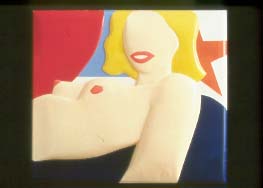
| |
| ADAA AT THE ARMORY—Tom Wesselmann's "Great American Nude." | |
PaceWildenstein showed Picasso Miniatures. Matthew Marks Gallery featured works of Brice Marden and Ellsworth Kelly. Jeffrey H. Loria presented a full set of Honoré Daumier's 36 busts of 19th century French politicians.
In the wake of the fantastic Outsider Art Show in Soho at the Puck Building—where the works of naïf and mentally disturbed artists often seemed more interesting than anything shown at the Whitney Buy-Annuals—Galerie St. Etienne was offering some of its collection of Henry Darger fantasies. Darger was obsessed with pretty pre-teen girls, pursued and sore beset by bandits, Legionnaires, and other menacing males.
But St. Etienne also had a powerful if unknown "disturbed" artist in its own gallery show of Art Brut in the Land of Freud. This was the former porcelain-painter Josef Karl Rädler, whose manic phases and mood-swings caused his family to commit him. His meticulously worked pictures are always framed with colored margins decorated with tiny designs and writing. Blocks of decorated texts are also above or below the main images. Impressive and haunting!
The Maxwell Davidson Gallery offered Tom Wesselmann's Great American Nude. Barbara Mathes exposed Mondrian's A Chrysanthemum to public view and possible sale. Andy Warhol's silk-screen Jackie was in the C&M Arts booth.
Many fine artworks by major talents, now enshrined in Art History, were up for sale. Among the artists: Gustave Courbet, Winslow Homer, Gustav Klimt, Childe Hassam, Diego Rivera, Marcel Duchamp, Max Ernst, etc., etc.
While paintings may well be pricey, for those who long to own a work-on-paper by a noted artist some etchings and limited-run prints are often quite reasonable.
This show was rapidly followed by Sanford L. Smith's Works on Paper. Maybe they should leave the Armory booths in place, instead of dismantling them and setting them up again so soon? And why not leave the Police Barricades on Fifth Avenue permanently in place for the endless ethnic parades up and down this famed boulevard?
The annual Works on Paper show is always exciting—especially for me, as I've long collected engravings, prints, wood-cuts, and photographs. And each year, new talents emerge, while old favorites are often represented by images not seen on sale for some time.
The range of this show is Old Master to Contemporary. An Albrecht Dürer may well be beyond your bank-account, but there will always be some contemporary prints well within the resources of someone really intent on owning a print from a limited edition.
This show features no dining-tables or elephant-foot wastebaskets. The main criterion is that the work must be On Paper. Under this rubric, Prints, Posters, Watercolors, Drawings, and Illustrated Books are admissible. Photographs printed on paper are also welcomed, but Kodachrome slides are not.
This March some 90 exhibitors from seven nations showed their art-wares. I found many works to admire and desire. In some booths, I coveted almost everything on display. But I already have too many works-on-paper myself and need to reduce the inventory somehow.
[My immense Infotography photo-archive is to be deposited in the Photographic Collection of the Research Libraries at the New York Public Library on 42nd Street, in fact.]
Among works I admired were Safet Zec's views of Venice, at Mark Murray Fine Paintings. Adnan Charara's Decoesque Man & Machine series recall WPA murals and a whiff of Escher.
Los Angeles' Papillon Gallery showed a number of colorful French works from the 1920s through the war years. Some were strikingly vintage Art Deco. Deco images were also very strong in the Conner.Rosenkranz booth.
Both the Aaron Galleries and Abigail Furey regularly issue fine black & white glossy catalogues of artists they have for sale. The Aaron catalogue of Rockwell Kent's works is especially impressive.
Vivian Kiechel is offering some outstanding drawings and prints by Thomas Hart Benton. His sketches for LIFE magazine of the Hollywood motion-picture industry at work are fascinating.
Among Pia Gallo's small but lovely catalogues was one on Angels on Paper and another of Pietro Testa's 17th century etchings of wildly baroque religious images.
Frederick Baker's offerings include handsome drawings by Milton Avery and nostalgic Depression Era prints by Martin Lewis.
James Cummins Bookseller displayed some memorable photos, autographs, first-editions, and fine bindings. Autographs ranged from Einstein to Woolf and Whitman.
From 7 through 11 March, the Wendy's management offers its New York Armory Antiques Show in the same venue. But, even with some of the same galleries and antique stores showing, the totality is not the same. There isn't the same attention to the decoration of the booths as at the Winter Antiques Show.
And some of the antiques are by now Old Friends. Why would anyone want to drag a long, long dining-table and chairs down from Connecticut, season after season? Or does it actually sell, replaced next season by a similar one?
If I were seized by an uncontrollable desire to be an antiques-dealer, I think I'd want to deal in very small-scale objects: snuff-boxes, netsukes, fans, perfume-bottles, rare buttons, thin sheets of engravings and prints. No bulky furniture or Grandfather Clocks!
This is the same principle as becoming an orchestral musician: pick the piccolo or the flute, not the bass or the tympani. [Loney]
Copyright © Glenn Loney 2001. No re-publication or broadcast use without proper credit of authorship. Suggested credit line: "Glenn Loney, Curator's Choice." Reproduction rights please contact: jslaff@nymuseums.com.